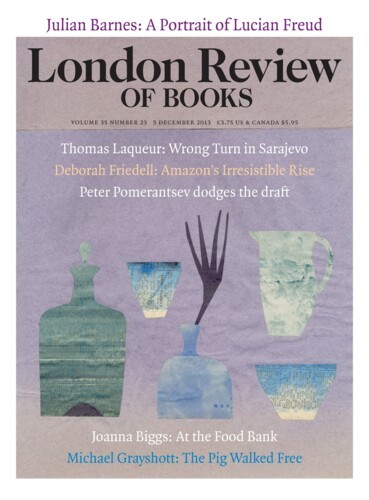Silhouettes are polite, a parlour art, practised in gemütlich Vienna and Berlin among families who also formed quartets and played the piano; they were often made by the same accomplished daughter who would perform at home for a soirée. The art’s antecedents are Asian: an Egyptian shadow puppet, dating back millennia, featured recently in the British Museum exhibition about the Arabian horse, and in Indonesia and India puppeteers, working with perforated figures on sticks against candle flames, still recite sacred epics. But as time passed in the West, clever scissorwork became a young woman’s skill, and dropped below stairs; the bastard progeny of the paper cut are the doily and the cutlet frill. Yet Lotte Reiniger, a Berliner who died in London in 1981, adapted the craft to make experimental ‘shadow films’, as she called them, turning the pastime into an art form with her ambitious full-length animation, The Adventures of Prince Achmed (1926) and her later, whimsical children’s shorts for pantomime and TV.
Kara Walker talks about her own art as a way of playing, and comments on the uncanny intimacy of the medium as she manipulates her figures, but rather oddly, avoids mentioning Reiniger (as far as I can see). Yet Reiniger’s articulated shadow puppets, with their crooked, expressive fingers, rolling eyes and tufts of unruly hair springing from the silhouette outlines, inform Walker’s energetic caricatures, while other techniques – for example, the use of superimposed lengths of coloured tissue paper – identify her as one of Reiniger’s daughters, especially in the powerful film Fall frum Grace: Miss Pipi’s Blue Tale, one of the most compelling exhibits in this solo show at the Camden Arts Centre (until 5 January).
Since her incendiary success more than twenty years ago, Walker has vitiated the decorum of paper cuts with a vengeful, cold relish. From a distance her friezes of silhouette figures look innocuous – a paper chain of dolls or an ornament by Arthur Rackham in a fairy story. Come a little closer and they start to distort and twist like faces in a fairground mirror. A portly, elderly gent is doing something unspeakable with a charming little girl, as the bows bounce on her plaits; a gracious châtelaine with a young black boy and a darling little capering dog are engaged in something so outlandish that you look on shaken at the filth materialising under your eyes. ‘Auntie Walker’s Samplers’, the new works on the walls in Camden Arts Centre, made in situ for one of the rooms, depict acts of genital cruelty and class tyranny remembered by witnesses to the abuse of slaves and told to abolitionists. The results are as disturbing as anything in Goya’s Disasters of War or the Chapman Brothers’ defacings of Goya.
Since her earliest works, such as The End of Uncle Tom and the Grand Allegorical Tableau of Eva in Heaven (1995), Walker has shown astonishing fluidity in the domestic skill of silhouette portraiture, in order to revisit the history of slavery. She still draws on slaves’ own stories, and the winsome title of this exhibition parodies their style, landing firmly at the close on an N-word: We at Camden Arts Centre Are Exceedingly Proud to Present an Exhibition of Capable Artworks by the Notable Hand of the Celebrated American, Kara Elizabeth Walker, Negress. This is very much the artist’s trademark, flouting the pieties which in her view conceal modern-day realities. The work of more recent historians of the Civil War and the plantations also inspires her later polemical fictions on the screen as well as the page: her art has a deep rapport with Toni Morrison’s Beloved. She stirs up ghosts and has no hand in laying them to rest.
The centre wall of samplers deploys white figures cut from black paper: the subjects are all absences. This frieze, The Sovereign Citizens’ Sesquicentennial Civil War Celebration, brings the story from the plantation into the present, even though the cast of characters look unchangingly antebellum. (William Kentridge, the South African artist and filmmaker who also alludes to magic-lantern shows, has staged similarly ironic festivities and pageants – though with a more raucous sense of drama – as he too explores the changing tensions around race in contemporary America and Africa.) Like her central procession of cut-outs, Walker’s large charcoal drawings from a series called Dust Jackets for the Niggerati bring her inquiry closer to the present day, as she imagines works that could or should be written now (‘African … Africould’ve Africould’ form a sequence she has written).
In the interview screened in the show, she says she has been immersed in white supremacist writing, driving herself giddy and mad: her images return obsessively to stock fantasies of rape and abjection, rage and docility, hatred and nurture, Uncle Tom and Aunt Jemima. None of the horrors of slavery, she seems to say, has been set aside or overcome. But beyond the hoods of the Klan, or the obsession with cockmanship, it’s difficult to understand what the drawings are about if you aren’t immersed in the materials Walker has explored with such relentlessness. A long, hard struggle with racial defamation is still going on, but should older nightmares be revived in the process? This is the question Tony Judt asks at the end of Postwar, in relation to the Holocaust. Can letting go offer a kind of renewal, or is it merely a convenience for oppressors and bystanders?
In the mid-1990s black artists were angered by Walker’s insistence on raising these ghosts. When she was given a MacArthur ‘genius’ award in 1997, the American assemblage artist Betye Saar organised a letter-writing campaign questioning ‘the validity of a black person’s attempt to reclaim and reverse racist imagery through irony’. Thom Shaw, another artist who prefers to be called African-American, commented: ‘We’re still looked at as Sambos.’ Walker admits to drawing on minstrel imagery; Uncle Tom and Aunt Jemima and the Tar Baby reappear in her cast of characters, along with golliwogs and other stereotypes, but she argues that she is voiding them of their power: ‘My work attempts to take those “pickaninny” images and put them up there and eradicate them.’ Yet there has been continued bitterness about her approach among strategic anti-racists favouring black role models, heroes and heroines of emancipation, Sojourner Truths and Mary Seacoles. Walker’s invocation of abject and comic or terrorising and savage ancestral ghosts has made her work an object of desire for collectors, connoisseurs and bankers. I once went to an opening in New York, followed by a smart party in a collector’s apartment. One room was lined with Kara Walkers, and it’s hard to convey how it felt to be wining and dining surrounded by pictures of race porn, floggings, burnings and lynchings, all done in that imperturbable maidenly form of the paper cut. A contemporary artist who succeeds in the art world can fall under a different regime of possession: branding. The term has a horrible reverberation in the context of Walker’s work.
After the Deluge, her response to Hurricane Katrina – originally an installation, now a book (Rizzoli, £16.95) – gives prominence to a quotation from Fanon: ‘I am not the prisoner of history. I should not seek there for the meaning of my destiny.’ Walker’s subjects are given black masks, projected from the fantasy of whites, male and female, in a sustained act of counter-mimicry: they co-opt the enemy’s fearsome labelling, to deflect the terror back onto its source. It’s a fundamental manoeuvre in the natural world – including among humans – designed to neutralise adversaries. In rituals, the terms don’t need to evolve; indeed continuity counts and images stay the same: St George has spiny armour like a dragon’s in order to face the beast, St Michael ditto in his victory over Satan. But art is ceremony only up to a point. Artists can be imprisoned by the art world’s expectations, condemned to repeat the story that brought them to its attention. Their work may have the comforting assurance of repeated ritual, but it loses energy, and though it’s not the transgressors’ fault when their line in outrageous blasphemy becomes all the rage, it defangs their bite.
The friezes of silhouettes in this show are Walker’s stock in trade, her equity, her brand. Their shock tactics feel well rehearsed rather than explosive. Other works experiment with less ironical forms of resistance and survival. In one of her expansive, convulsed drawings, she seems to be depicting adult baptism – a foray into the pervasive role of religion in the history of black emancipation. Sketch for an American Comic Opera with 20th-Century Race Riot is a turbulent, scrawly triptych drawn last year. In both the results are ambiguous, lacking the pure blowtorch virulence of her Southern moralities. The characterisation still alludes to the cartoon figures in her cut-outs, but at least she is engaging with tensions and choices that are recognisable to us now.
In her writings, Walker drops her masks; her voice is immediate, at once self-lacerating and self-protective as she confronts her critics. No doilies, no frills; art as armour for mind and body:
I make art for white boys to feel up their sisters at
no.
no shame.
I make art for white girls to finger thier prissies
no.
no shame in that
I make art for artists to fire thier furnace
I make art for Kara, so that she wont burn us.
Send Letters To:
The Editor
London Review of Books,
28 Little Russell Street
London, WC1A 2HN
letters@lrb.co.uk
Please include name, address, and a telephone number.


